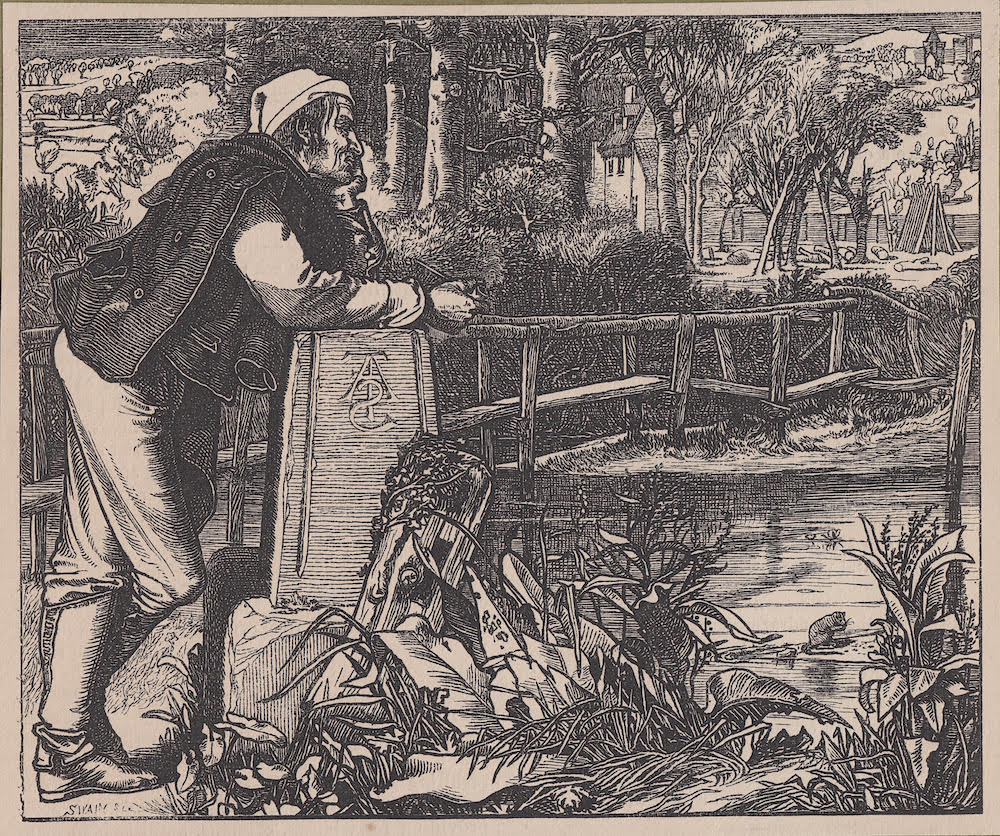
The Old Chartist by Frederick Sandys. Frontispiece to George Meredith's Poems, Vol. I (Memorial Edition, Vol. XXIV), but originally accompanying the poem in the magazine Once a Week, 8 February 1862. [Click on the image for a larger picture.]
At the time Meredith was writing the poems in his second volume of poetry, Modern Love and Poems of the English Roadside, with Poems and Ballads (1862), where this was published after his better-known sonnet sequence. He was then living in Copsham Cottage in Esher, with heathland and woods all around. Copsham Common in particular seems to have attracted him. "This was a great resort for gipsies and tinkers, with whom he enjoyed conversing, thereby acquiring much first-hand knowledge of which he was to make good use" (Sassoon 43). "The Old Chartist" was one of the poems that drew on this knowledge, and his own feelings about and hopes for the brotherhood of man. Keith Hanley writes, "The subject of this poem appreciates the changed conditions of relative prosperity in mid-Victorian Britain ... but he still insists on the relevance of his basic old convictions" (111n.).
Meredith moved in artistic circles during these Esher years: in the summer of 1862 he even entered into a short-lived agreement with Dante Gabriel Rossetti to become a sub-tenant of his house in Cheyne Walk, Chelsea, along with Swinburne and William Rossetti, for the days he had to spend in London. Sandys was a good friend, who would later make a delicate pencil and watercolour portrait of Meredith's second wife, Marie — very different from this illustration with its bold lines, and of course much more suitable to its subject and for its purpose. — Jacqueline Banerjee
Commentary by Dennis T. Lanigan

Wood engraving of 1862 by Joseph Swain in black ink on cream paper; 4 ¼ x 5 inches (10.7 x 12.7). Private collection, courtesy of Lanigan. [Click on the image to enlarge it.]
The finished drawing for this composition, once in the James Anderson Rose collection, is unlocated and only a pencil tracing for transfer of the design to the woodblock remains to give an indication as to what the original drawing would have looked like. This tracing, obviously in reverse as compared to the print, is in the collection of the Fitzwilliam Museum, Cambridge. Betty Elzea has described the composition of the tracing:
A middle-aged man in peasant clothing leans on an upright stone slab and looks over a stream with a rough wooden bridge. In the foreground is the near bank upon which is a tree stump and wild plants. A water rat grooms himself on a sandbar in the stream. Beyond the far bank is a grove of trees and a cottage, and to the left, is a charcoal burner building his wood pile. Beyond this is a village on a hill. To the right is a distant view of flat fields and rising ground with groves of trees. In the print, Sandys has drawn his monogram 'AFS' as if it were incised on the stone slab. [208]
Elzea feels that in the strong outline and the precision of the drawing this illustration was once again influenced by German woodcut artists of the fifteenth century and their nineteenth century successors like Alfred Rethel (208).
As noted above, the print illustrated George Meredith's poem, "The Old Chartist," when it first appeared in the periodical, Once a Week, where "it admirably reflects the feeling and the atmosphere of the poem" recalling the working-class Chartist movement (Elzea 208). The illustration was reprinted in 1876 in G. W. Thornbury's Historical and Legendary Ballads and Songs where it was used in an mismatched manner to illustrate Thornbury's poem "The Miller's Meadow."
According to Percy Bate, Sandys's illustration The Old Chartist was a masterpiece and Sandys's own favourite of his illustrations (3, 4). Forrest Reid also rated it very highly: "Of the three designs in Once a Week, vol. vi, the Düreresque Old Chartist is his most famous drawing. The subject here is taken neither from legend nor from the past, the old Chartist of George Meredith's poem is simply an English working man, leaning in meditation over a bridge, beneath which a brook flows through a woody landscape, and a water-rat 'washes his old poll with busy paws'" (59).
First image downloaded by Jacqueline Banerjee; second one, courtesy of Lanigan. You may use both the images without prior permission for any scholarly or educational purpose as long as you (1) credit the source and (2) link your document to this URL in a web document or cite it in a print one.
Combined Bibliography
Bate, Percy "The Late Frederick Sandys: A Retrospective." The Studio XXXIII (October 1904): 3-17.
Elzea, Betty. Frederick Sandys 1829-1904. A Catalogue Raisonné. Woodbridge, Suffolk: The Antique Collectors' Club Ltd., 2001, cat. 2.B.30, 208-09.
Hanley, Keith, ed. George Meredith: Selected Poems. Manchester: Carcanet, 1988 (last copyright on Introduction, Selection and Notes, 2001).
Meredith, George. Poems, Vol. I. Memorial Edition, Vol. XXiV. New York: Scribner's, 1910. Internet Archive. Web. 5 May 2013.
Reid, Forrest. Illustrators of the Sixties. London: Faber & Gwyer Limited, 1928.
Sassoon, Siegfried.Meredith. London: Arrow, 1959.
Created 5 May 2013
Last modified (commentary added) 23 August 2025